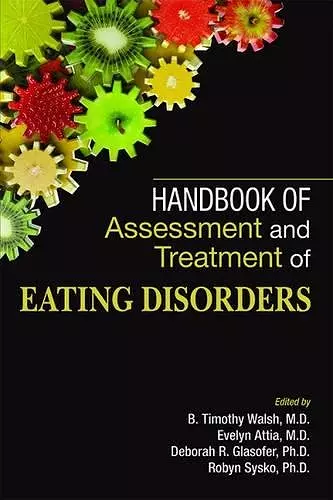Handbook of Assessment and Treatment of Eating Disorders
B Timothy Walsh editor Evelyn Attia editor Deborah R Glasofer editor Robyn Sysko editor
Format:Paperback
Publisher:American Psychiatric Association Publishing
Published:8th Dec '15
Currently unavailable, our supplier has not provided us a restock date

Dr. Timothy Walsh is one of the world's leading authorities on eating disorders. This well-researched and thorough guide, which he co-authored on the subject, will not only help clinicians and researchers better understand the condition, but also enable sufferers to get the help they so desperately need and deserve. Joy Bauer MS, RDN -- Nutrition and Health expert for NBC's TODAY Show, #1 New York Times bestselling author and founder of Nourish Snacks This "Handbook" is actually an "encyclopedic" compendium of the most current research and state-of-the-art practical applications for the diagnosis and treatment of eating disorders. The authors throughout this book are among the pre-eminent scholars and clinicians in this field, yet the writing is always accessible and relevant. This handy text will no doubt become the "go to" resource for a multi-disciplinary group of clinicians as well as academics. Andrea Marks M.D., Associate Clinical Professor of Pediatrics, Icahn School of Medicine at Mount Sinai, AYAM: Adolescent-Young Adult Medicine
Chapters on assessment and treatment, along with accompanying videos, offer comprehensive, state-of-the-art coverage that will benefit clinicians in practice, such as psychiatrists and psychotherapists, as well as mental health trainees.
The recent publication of the revised Diagnostic and Statistical Manual of Mental Disorders (DSM-5) has had a profound impact on the classification of eating disorders, introducing changes that were formalized after years of study by the Eating Disorders Work Group. The Handbook of Assessment and Treatment of Eating Disorders is the only book that provides clinicians with everything they need to know to implement these changes in assessment, diagnosis, and treatment. After an overview of feeding and eating disorders that systematically reviews the changes from DSM-IV to DSM-5, some of the foremost scholars in each area address eating disorders in adults, children and adolescents, and special populations. Chapters on assessment and treatment, along with accompanying videos, offer comprehensive, state-of-the-art coverage that will benefit clinicians in practice, such as psychiatrists and psychotherapists, as well as mental health trainees.
Clinicians will find the following features and content especially useful:
• Five full chapters on assessment tools cover the evolution of measures and instruments, from the primitive beginnings to the cutting edge of new technological applications. The challenges of diagnosing feeding and eating disorders in children and adolescents are also addressed.
• Treatment chapters cover restrictive eating, including anorexia nervosa and avoidant/restrictive food intake disorder, binge eating, including bulimia nervosa and binge-eating disorder, and other eating problems, including pica, rumination disorder, and night eating syndrome.
• One chapter focuses on eating problems among men and boys, who have diverse presentations, and the motivations and body image disturbances that may differ from those typically found among females.
• Because attunement to culturally and socially patterned characteristics of clinical presentation is essential to an informed and accurate mental health assessment, an entire chapter is devoted to clinical effectiveness in multicultural and cross-cultural settings.
• Each chapter ends with key clinical points to help readers focus on the most salient content, test comprehension, and review for examinations.
Clinicians in both training and practice will find the book's up-to-date, DSM-5–compatible content to be utterly essential. The Handbook of Assessment and Treatment of Eating Disorders belongs in the library of every mental health professional practicing today.
This book attempts to be useful to a diverse array of practitioners, both psychologists and psychiatrists. It's particularly in-depth discussion about various psychotherapies and assessment measures may make it more appropriate for psychologists, but it may be just as useful for psychiatry residents wanting to explore the area of eating disorders more. Sections on psychopharmacology, while possibly superficial, are also helpful in an introductory sense. The discussion of the updated DSM classification, including the reasons for such changes, was particularly useful. Readers will likely find this book gives them a greater appreciation for screening for and treating eating disorders, as well as making them feel more comfortable treating such disorders.
-- Michael Byrne, MD(Rush University Medical Center) * DooISBN: 9781585625093
Dimensions: 229mm x 152mm x 15mm
Weight: 585g
358 pages